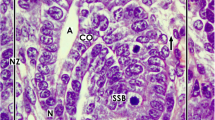Summary
At the start of its morphogenesis the tubule of an S-shaped body always attaches to the terminal ampulla of the collecting duct. It remains attached there for some time while the terminal ampulla sprouts toward the renal capsule. The most distal part of the tubule that rises to the ampulla forms the connecting tubule, morphogenically the oldest segment of the tubulus nephroni. When younger S-shaped bodies join the same terminal ampulla, 2 to 3 connecting tubules are temporarily attached side by side to a single ampulla. Soon, however, the connecting tubule of the older nephron shifts its point of attachment away from the ampulla to the connecting tubule of the younger nephron. This process is repeated through successive nephron generations. Thus an arcade develops which at the close of morphogenesis includes the connecting tubules of the 3 to 4 oldest juxtamedullary and midcortical nephrons of the collecting duct and is always situated close to interlobular veins. The connecting tubules of the 2 youngest subcapsular nephrons are not incorporated into arcades, but join directly and permanently the collecting duct. — At the start of histogenesis, the undifferentiated tubule epithelium of the S-shaped body has a uniform structure over its entire length. At the junction of the connecting tubule and the terminal ampulla there is a cytologically sharp boundary between cuboidal, dark-stained connecting-tubule epithelium of the nephron and cylindrical, light-stained ampullary epithelium of the collecting duct. The epithelial differentiation begins in the oldest, juxtamedullary connecting tubules of an arcade and progresses upward to the terminal ampulla, so that immature connecting-tubule epithelium and immature ampullary epithelium are temporarily interposed between mature connecting-tubule epithelium and mature collecting-duct epithelium. The mature epithelium of the connecting tubule stains light, in which respect it behaves like the epithelium of the distal tubule. However, it also contains individual cells that are more strongly basophilic, stain dark and, though of nephrogenic origin, cannot be distinguished from the dark cells of the collecting duct by light microscopy. — Morphogenically and histogenically, the arcade-forming connecting tubules and the subcapsular connecting tubules arise from the nephrogenic blastema.
Similar content being viewed by others
References
Bankir L, Kaissling B, de Rouffignac C, Kriz W (1979) The vascular organization of the kidney of Psammomys obesus. Anat Embryol 155:149–160
Bargmann W (1978) Handbuch der mikroskopischen Anatomie des Menschen. Bd. VII/5 Niere und ableitende Harnwege. Springer, Berlin Heidelberg New York, p 444
Crayen M, Thoenes W (1975) Architektur und cytologische Charakterisierung des distalen Tubulus der Rattenniere. Fortschr. Zool 23:279–288
Ericsson JLE, Trump BF (1969) Electron microscopy of the uriniferous tubules in: Rouiller C, Muller AF (eds) The Kidney Vol I, p 351–447 Academic Press, New York London
Goncharevskaya OA, Dlouhá H (1975) The development of various generations of nephrons during postnatal ontogenesis in the rat. Anat Rec 182:367–376
Hamburger O (1890) Über die Entwicklung der Säugethierniere. Arch Anat Physiol Suppl p 15–51
Huber GC (1905) On the development and shape of human uriniferous tubules of certain higher mammals. Am J Anat Suppl 4:1–98
Jokelainen P (1963) An electron microscope study of the early development of the rat metanephric nephron. Acta Anat Suppl 47:1–73
Kaissling B (1980) Ultrastructural organization of the transition from the distal nephron to the collecting duct in the desert rodent Psammomys obesus. Cell Tissue Res 212:475–495
Kaissling B, Kriz W (1979) Structural analysis of the rabbit kidney. Adv Anat Embryol Cell Biol 56:1–123
Karnovsky MJ (1965) A formaldehyde-glutaraldehyde fixative of high osmolality for use in electron microscopy. J Cell Biol 27:137A-138A
Kazimierczak J (1971) Development of the renal corpuscle and the iuxtaglomerular apparatus. Acta Pathol Microbiol Scand Section A Suppl 218:1–65
Kazimierczak J (1978) Topography and structure of vasculature in developing cortex of rat kidney. Anat Embryol 153:213–226
Kriz W (1967) Der architektonische und funktionelle Aufbau der Rattenniere. Z Zellforsch 82:495–535
Kriz W, Schnermann J, Koepsell H (1972) The position of short and long loops of Henle in the rat kidney. Z Anat Entwicklungsgesch 138:301–319
Larsson L (1975a) The ultrastructure of the developing proximal tubule in the rat kidney. J Ultrastruc Res 51:119–139
Larsson L (1975b) Effects of different fixatives on the ultrastructure of the developing proximal tubule in the rat kidney. J Ultrastruc Res 51:140–151
Mayor HD, Hampton JC, Rosario B (1961) A simple method for removing the resin from epoxy-embedded tissue. J Cell Biol 9:909–910
Möllendorff Wv (1930) Der Exkertionsapparat. In: Handbuch der mikroskopischen Anatomie des Menschen. Bd. VII/1 Harn-und Geschlechtsorgane. Springer, Berlin, pp 1–328
Neiss WF (1982a) Die Morphogenese von Arkaden in der Rinde und das Längenwachstum des Markes in der Nachniere der Wistarratte. Verh Anat Ges 76
Neiss WF (1982b) Histogenesis of the loop of Henle in the rat kidney. Anat Embryol 95
Neiss WF, Klehn KL (1981) The postnatal development of the rat kidney, with special reference to the chemodifferentiation of the proximal tubule. Histochemistry 73:251–268
Oliver J (1968) Nephrons and kidneys. Harper & Row, New York Evanston London, p 117
Osathanondh V, Potter EL (1963) Development of human kidney as shown by microdissection. III. Formation and interrelationship of collecting tubules and nephrons. Arch Pathol 76:290–302
Peter K (1927) Untersuchungen über Bau und Entwicklung der Niere. V. Die Entwicklung der menschlichen Niere nach Isolationspräparaten. VI. Der Ausbau der Nierensubstanz. Fischer, Jena Vol. 2:522–647
Rhodin J (1958) Anatomy of kidney tubules. Int Rev Cytol 7:485–534
Richardson KC, Jarett L, Finke EH (1960) Embedding in epoxy resins for ultrathin sectioning in electron microscopy. Stain Technol 35:313–323
Rollhäuser H, Kriz W, Heinke W (1964) Das Gefäß-System der Rattenniere. Z Zellforsch 64:381–403
Stoerk O (1904) Beitrag zur Kenntnis des Aufbaus der menschlichen Niere. Anat Hefte 23:283–329
Teutsch HF (1974) Histochemie des Metanephros beim Goldhamster. I. Glykogen, RNS, LDH, SDH und G6PDH während der Organogenese. Histochemistry 39:171–192
Author information
Authors and Affiliations
Additional information
Supported by the Deutsche Forschungsgemeinschaft (SFB 105)
Rights and permissions
About this article
Cite this article
Neiss, W.F. Morphogenesis and histogenesis of the connecting tubule in the rat kidney. Anat Embryol 165, 81–95 (1982). https://doi.org/10.1007/BF00304585
Accepted:
Issue Date:
DOI: https://doi.org/10.1007/BF00304585




